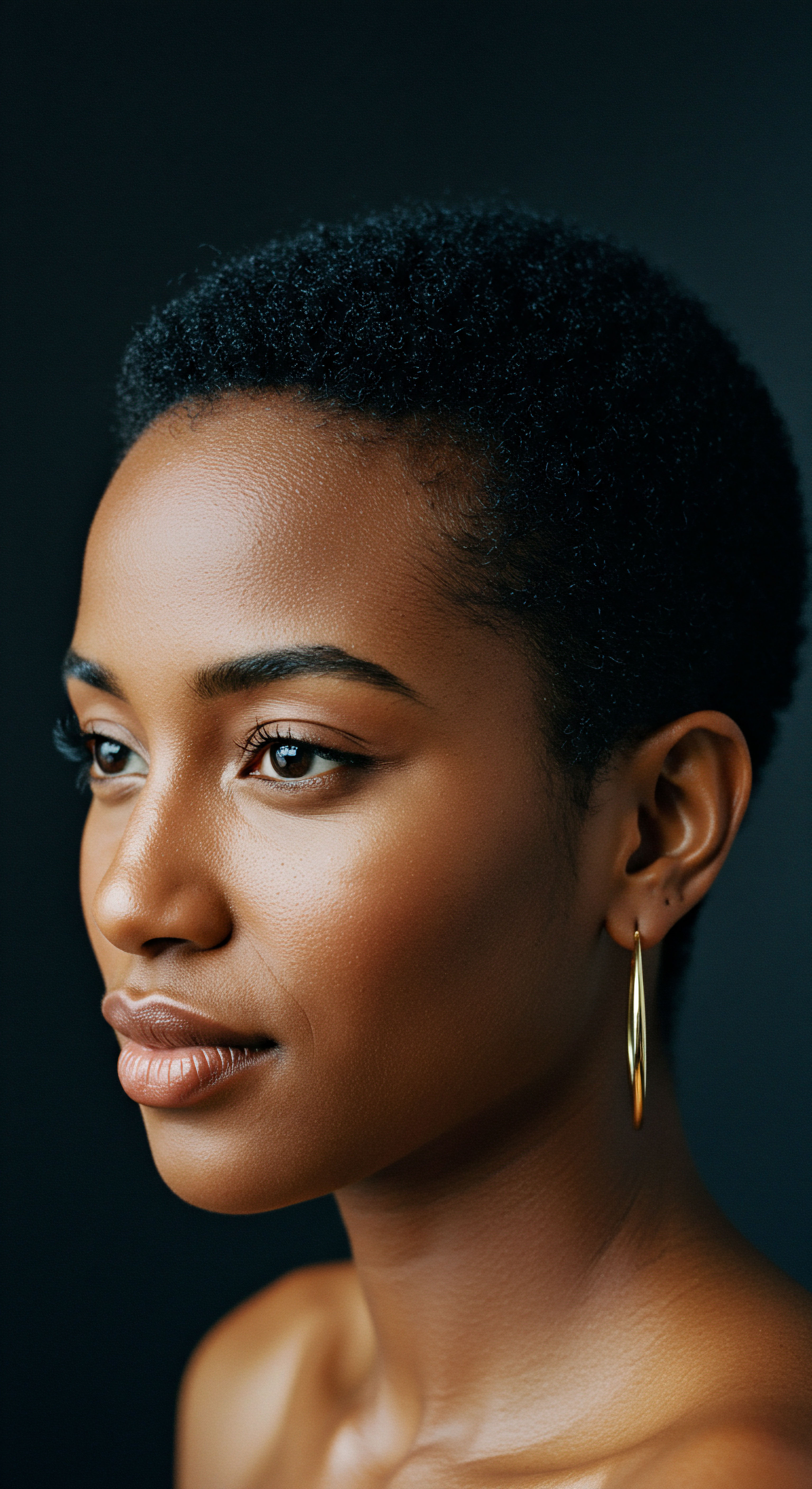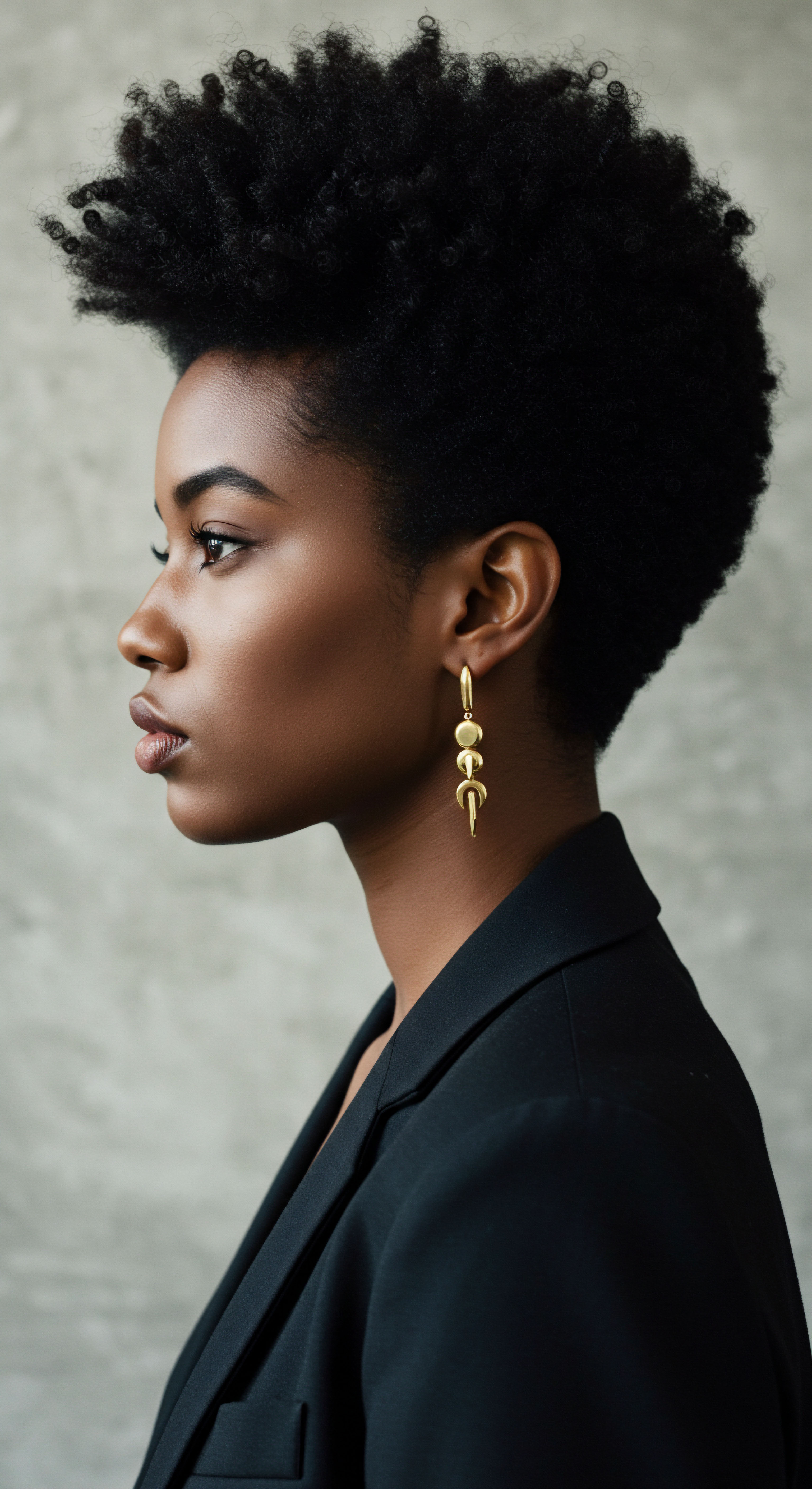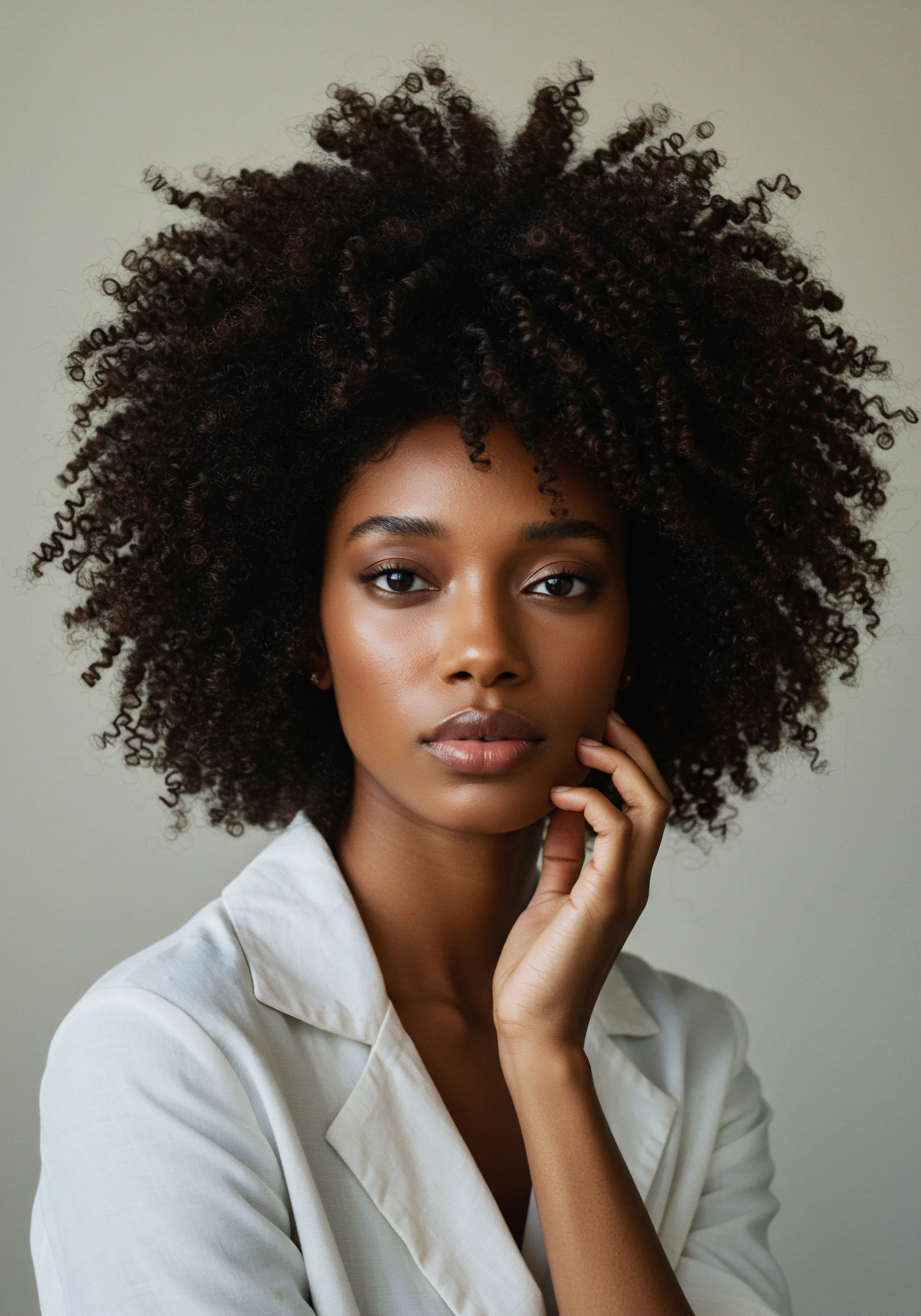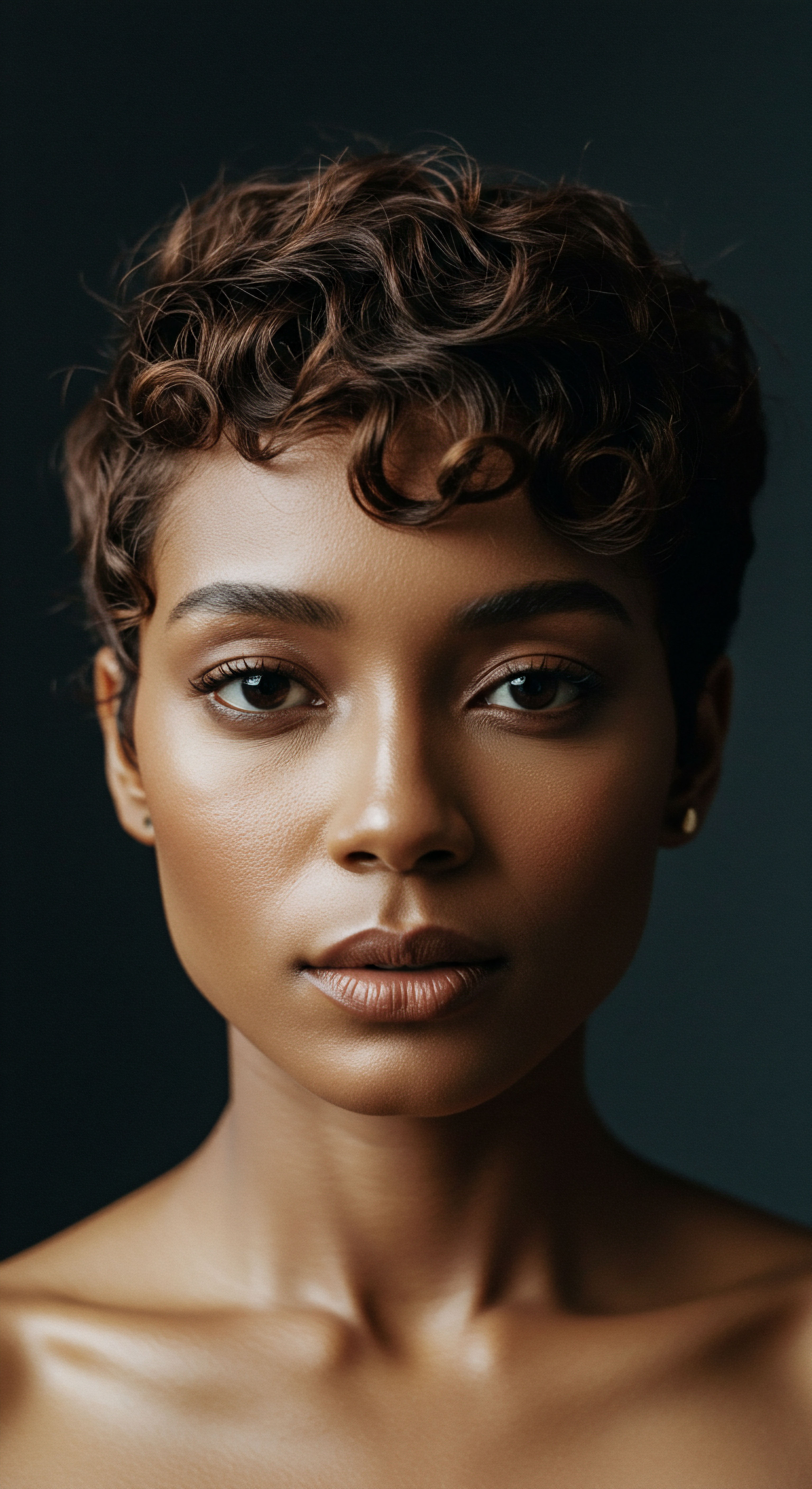
Roots
A quiet hum courses through the world, a subtle yet persistent call from ancestral lands and timeless practices, beckoning us to reconsider our relationship with textured hair. For too long, the vibrant coils, kinks, and waves that crown so many heads have been viewed through a lens of deficiency, a perceived need for taming or alteration. Yet, beneath this contemporary gaze lies a profound heritage, a legacy of understanding that saw hair not as a challenge, but as a living extension of self, deeply connected to wellbeing.
This wisdom, passed through generations, holds vital insights for today’s holistic health approaches, offering a path toward reverence for our unique strands. It is a journey into the very fiber of our being, inviting us to rediscover a harmony that was once universally acknowledged.

The Intrinsic Architecture of Textured Hair
The physical structure of textured hair is a marvel of natural design, differing significantly from straight hair types in its follicular shape and growth pattern. Unlike the round, symmetrical follicles that produce straight hair, textured hair emerges from an elliptical or ribbon-like follicle, causing the hair shaft to bend and twist as it grows. This inherent curvature results in multiple points along the strand where the cuticle, the outermost protective layer, is raised or less uniform. These raised cuticles contribute to the characteristic volume and resilience of textured hair, but also render it more susceptible to moisture loss and mechanical stress.
The unique arrangement means that natural oils, produced by the scalp, travel with greater difficulty down the coiled shaft, leading to a predisposition towards dryness. Understanding this foundational anatomy is not merely academic; it unlocks the ‘why’ behind many traditional care practices, which intuitively addressed these specific needs.
Consider the variations within textured hair itself ❉ from loose waves to tightly compacted coils. These differences are a spectrum of genetic expression, influencing everything from curl diameter to strand density. A single head might display several distinct patterns, each with its own hydration requirements and breakage vulnerabilities. This diversity within the textured hair community highlights the importance of individualized care, a concept deeply ingrained in ancient approaches that observed and responded to each person’s unique hair characteristics.
Textured hair, a marvel of natural design, emerges from uniquely shaped follicles, predisposing it to dryness and requiring tailored care.

Classifying Hair’s Natural Patterns
Modern classification systems for textured hair, while useful for communication, often simplify a far more complex reality. The widely recognized numerical and alphabetical system (e.g. 3A, 4C) attempts to categorize curl patterns based on their shape and tightness. While it provides a starting point for product selection and styling guidance, ancient communities possessed a more intuitive, experiential classification.
They recognized not just curl pattern, but also hair’s feel, its response to moisture, its elasticity, and its overall disposition. This observational wisdom allowed for a truly personalized approach, long before scientific instruments could measure porosity or density.
- Curl Pattern ❉ The visual shape of the strand, from a loose S-wave to a tight Z-coil.
- Density ❉ The number of individual hair strands on the scalp, impacting overall volume.
- Porosity ❉ The hair’s ability to absorb and retain moisture, influenced by cuticle integrity.
- Elasticity ❉ The hair’s capacity to stretch and return to its original length without breaking.
The understanding of these elements, though perhaps not articulated in scientific terms, guided the selection of specific plant extracts, application methods, and styling techniques. For instance, communities with hair types prone to significant shrinkage might have developed elongation techniques or protective styles to maintain perceived length and prevent tangling. Those with very dry hair might have relied heavily on rich butters and oils, applied frequently. This holistic view of hair characteristics was foundational to their successful care strategies.

An Ancestral Lexicon for Hair Care
Beyond classification, ancient cultures developed a rich vocabulary for hair, not just for its physical attributes but for its cultural and spiritual significance. Hair was a symbol of status, identity, spirituality, and even resistance. Terms for different styles, states of hair, and care rituals carried deep meaning. The absence of negative descriptors often associated with textured hair in many contemporary languages speaks volumes about the reverence once held.
Instead, words conveyed strength, beauty, and connection to heritage. This linguistic framing reinforced a positive self-perception, a stark contrast to the historical pressures that often sought to diminish the beauty of natural textured hair.
The wisdom of these older languages reminds us that words possess power. How we speak about our hair, and ourselves, shapes our reality. Shifting from terms of ‘manageability’ or ‘control’ to words that honor hair’s natural vitality, its ‘resilience,’ its ‘graceful coils,’ or its ‘courageous volume,’ echoes this ancient respect. This seemingly subtle change in lexicon can profoundly influence one’s holistic relationship with their hair, moving away from a battle and towards a harmonious alliance.

Ritual
Stepping into the realm of ancient hair practices feels akin to entering a quiet sanctuary, where the rush of modern life gives way to intentionality and connection. The clamor for quick fixes and instant transformations often overshadows the profound rhythms that once governed hair care. Yet, beneath the surface of contemporary beauty routines, a deep yearning for meaning persists.
This section turns its attention to the practical wisdom embedded in historical hair rituals, exploring how these deliberate actions, far from being mere aesthetic gestures, formed a cornerstone of wellbeing. We examine the techniques, the tools, and the underlying philosophy that made these practices so enduringly relevant, inviting a re-evaluation of our own daily habits through a lens of holistic care.

Protective Styles ❉ A Timeless Shield for Strands
Across diverse cultures, particularly those with a prevalence of textured hair, protective styling emerged as a cornerstone of hair health. These styles, such as braids, twists, and locs, were not merely decorative; they served a vital function ❉ to shield delicate strands from environmental aggressors and reduce mechanical manipulation. By minimizing exposure to friction, tangling, and breakage, these styles allowed hair to retain length and moisture, promoting overall strength. The meticulous artistry involved in creating these styles often involved communal gatherings, transforming a personal care act into a shared cultural experience.
While modern iterations of protective styles remain popular, a crucial distinction lies in the approach. Ancient practices prioritized the health of the scalp and the integrity of the hair shaft, whereas some contemporary applications, driven by aesthetic trends, can sometimes compromise these principles. For instance, excessively tight braiding or the addition of heavy extensions can lead to unintended consequences.
A study published in the Journal of the American Academy of Dermatology found that an estimated one-third of African-American women experience traction alopecia, a form of hair loss resulting from prolonged tension on the hair follicle, with high-risk styles including tight braids, dreadlocks, weaves, and extensions, especially when applied to chemically treated hair. This statistic underscores the importance of adapting ancient wisdom with modern understanding, ensuring that protective styles truly protect, rather than inadvertently cause harm.
Ancient protective styling offered a shield for hair, a practice today’s wearers must balance with scalp health to prevent unintended strain.

Defining Natural Patterns with Gentle Methods
Before the advent of chemical straighteners or high-heat tools, ancient societies embraced and enhanced their hair’s natural patterns. Techniques focused on gentle definition, relying on natural ingredients and patient application. Finger coiling, braiding, and twisting were not just ways to style hair; they were methods to encourage curl formation, reduce frizz, and promote a cohesive look without altering the hair’s inherent structure. The tools were simple ❉ hands, wide-toothed combs crafted from natural materials, and sometimes specialized sticks or bone implements.
The focus was on working with the hair’s natural tendencies, rather than imposing a foreign shape upon it. This approach cultivated a deep respect for individual hair types. Applying botanical gels derived from plants like flaxseed or okra, or smoothing with rich butters, allowed curls to clump and define, reflecting the hair’s natural disposition. This gentle methodology stands in contrast to the high-tension, high-heat methods that became prevalent in later eras, often leading to damage and a disconnection from one’s authentic hair texture.

Scalp Care as a Foundation of Hair Vitality
Perhaps one of the most consistently relevant aspects of ancient hair care is the emphasis on scalp health. Cultures across the globe, from Ayurvedic traditions in India to African and Chinese practices, understood that a healthy scalp is the bedrock of vibrant hair. Scalp oiling, often combined with massage, was a widespread ritual. This was not merely about moisturizing; it was a therapeutic practice designed to stimulate blood flow, nourish hair follicles, and maintain a balanced scalp environment.
Modern scientific inquiry increasingly validates this ancient wisdom. Research suggests that regular scalp massage can significantly improve blood circulation to hair follicles, thereby enhancing nutrient delivery and promoting hair growth. A 2019 study involving over 300 individuals who engaged in daily scalp massages for several months reported that nearly 70% experienced reduced hair loss or increased hair regrowth. This highlights a direct scientific corroboration of practices that have existed for millennia.
Traditional ingredients used for scalp care included a diverse array of plant-based oils and herbs.
- Coconut Oil ❉ Known for its ability to penetrate the hair shaft and reduce protein loss.
- Castor Oil ❉ Valued for its purported ability to stimulate growth and its rich, thick consistency.
- Amla (Indian Gooseberry) ❉ Utilized in Ayurveda for its conditioning properties and promotion of hair health.
- Shea Butter ❉ A staple in African traditions, prized for its intense moisturizing and protective qualities.
- Neem Oil ❉ Employed for its antimicrobial properties, addressing scalp irritations and dandruff.
These applications were often accompanied by mindful massage techniques, turning a simple act into a meditative ritual that addressed both physical and energetic wellbeing. The practice of regularly cleansing the scalp with gentle, naturally derived cleansers, such as those made from soap nuts (Sapindus mukorossi) or shikakai (Acacia concinna), also ensured a healthy environment for hair to flourish, preventing product buildup and maintaining optimal pH.
| Ancient Practice Protective Styling (Braids, Twists) |
| Traditional Ingredients/Tools Hands, natural fibers, plant extracts for hold |
| Modern Scientific Relevance Reduces mechanical damage, length retention. Requires careful application to avoid traction alopecia. |
| Ancient Practice Scalp Oiling & Massage |
| Traditional Ingredients/Tools Coconut, Castor, Amla, Shea Butter, Neem oils; fingertips |
| Modern Scientific Relevance Increases blood circulation, nutrient delivery to follicles, stress reduction, promotes hair growth. |
| Ancient Practice Natural Cleansing |
| Traditional Ingredients/Tools Soap nuts, Shikakai, herbal infusions |
| Modern Scientific Relevance Gentle cleansing, maintains scalp pH, avoids harsh chemicals. |
| Ancient Practice These ancient methods provide a blueprint for modern holistic hair care, emphasizing preventative and nurturing approaches. |

Relay
As we delve deeper into the enduring legacy of ancient hair wisdom, the conversation shifts from fundamental understanding and daily rituals to the intricate interplay of culture, science, and societal influence. The query, “What ancient wisdom regarding textured hair care holds relevance for today’s holistic health approaches?”, opens pathways to a sophisticated exploration, moving beyond surface-level techniques to examine the profound connections between hair, identity, and wellbeing across time. This section aims to unravel the layers of this historical transmission, illuminating how ancestral knowledge, often dismissed or misunderstood, offers surprisingly robust frameworks for contemporary scientific inquiry and a more inclusive vision of health.

The Sociocultural Resonance of Hair Care
Hair, particularly textured hair, has historically served as a potent symbol within communities, signifying far more than mere aesthetics. In numerous African civilizations, hair designs communicated marital status, age, tribal affiliation, social standing, and even spiritual beliefs. The communal act of braiding or styling was not simply a chore; it was a moment of intergenerational teaching, storytelling, and bonding, solidifying social ties and transmitting cultural values. This collective dimension of hair care fostered a sense of belonging and reinforced cultural identity, acting as a powerful counter-narrative to external pressures that often sought to devalue natural hair textures.
This cultural anchoring meant that hair care practices were inherently holistic, addressing not only the physical condition of the hair but also the psychological and social wellbeing of the individual. The care rituals contributed to a positive self-perception and community cohesion. When these practices faced suppression or stigmatization during periods of colonization or assimilation, the impact extended beyond mere aesthetics, affecting self-esteem and cultural continuity. The ongoing “natural hair movement” today can be viewed as a contemporary echo of this ancient sociocultural resistance, a reclamation of identity and self-acceptance that draws strength from historical precedent.

Botanical Alchemy ❉ Bridging Ancient Ingredients and Modern Science
Ancient cultures possessed an extensive pharmacopoeia of plant-based ingredients, meticulously gathered and prepared for their purported benefits to hair and scalp. Their knowledge, accumulated through generations of observation and empirical testing, often predates modern scientific classification. For instance, the use of Chebe powder by the Basara Arab women in Chad for length retention has been documented through anthropological studies from the University of Cairo, noting its efficacy in harsh desert conditions.
Chemical analyses of Chebe have identified compounds like natural crystalline waxes and triglycerides that seal the hair cuticle and penetrate the hair shaft, alongside antioxidants and trace minerals supporting keratin structure. Similarly, Qasil from Somalia, a plant-based cleanser, demonstrates the sophisticated understanding of natural surfactants and conditioning agents.
The challenge for modern holistic health lies in systematically investigating these traditional botanical remedies. Ethnobotany, the study of the relationship between people and plants, plays a vital role here. Research into African plants used for hair conditions, for example, has identified numerous species with potential for hair growth and general hair care, with studies focusing on mechanisms such as 5α-reductase inhibition and the rate of telogen to anagen phase transition.
Can contemporary scientific methods truly quantify ancient wisdom?
The answer is complex. While modern science can isolate active compounds and measure their biological effects, it sometimes struggles to account for the synergistic actions of whole plant materials or the impact of traditional preparation methods. Many ancient remedies relied on complex mixtures, applied with specific rituals, where the combined effect may be greater than the sum of individual components.
For example, traditional hair oiling, a practice seen in Ayurvedic medicine, is now supported by research showing improved blood circulation and nutrient delivery to follicles, promoting hair growth. This scientific validation encourages a deeper respect for practices that were once considered merely anecdotal.

The Symbiotic Relationship of Hair Health and Overall Wellbeing
Ancient wisdom consistently positioned hair health within the broader context of overall physical, mental, and spiritual wellbeing. This holistic perspective contrasts sharply with a fragmented modern approach that often treats hair as a separate entity, detached from the body’s internal workings. Traditional systems like Ayurveda viewed hair as a direct reflection of one’s internal balance, with imbalances in diet, stress, or lifestyle manifesting as hair issues.
Consider the implications of this interconnectedness for today’s health challenges. For example, stress is a known contributor to hair loss in modern contexts. Ancient practices, through rituals like scalp massage, inherently addressed stress reduction, thereby supporting hair health indirectly.
Similarly, dietary practices in traditional societies, often rich in nutrient-dense whole foods, provided the necessary building blocks for healthy hair, reflecting the understanding that true beauty emanates from within. The shift towards processed foods and sedentary lifestyles in modern society often correlates with increased hair concerns, highlighting the enduring relevance of ancestral dietary principles.
| Aspect of Wellbeing Physical Health |
| Ancient Wisdom Application Topical plant applications, nourishing oils, scalp stimulation |
| Modern Holistic Connection Dermatological support, nutrient delivery, follicle stimulation |
| Aspect of Wellbeing Mental/Emotional Health |
| Ancient Wisdom Application Communal rituals, self-care practices, symbolic meaning of hair |
| Modern Holistic Connection Stress reduction, body positivity, cultural identity affirmation |
| Aspect of Wellbeing Environmental Connection |
| Ancient Wisdom Application Sustainable sourcing of natural ingredients, seasonal adaptations |
| Modern Holistic Connection Eco-conscious product choices, appreciation for natural cycles |
| Aspect of Wellbeing The enduring lesson is that hair health is not isolated; it mirrors the broader state of our existence. |

How can Historical Dietary Practices Influence Modern Hair Vitality?
The dietary patterns of ancient communities, particularly those with strong traditions of textured hair care, offer compelling insights for contemporary hair vitality. These diets were typically characterized by whole, unprocessed foods, abundant in vitamins, minerals, and antioxidants essential for cellular health, including that of hair follicles. For example, many African diets historically included diverse leafy greens, root vegetables, legumes, and lean proteins, providing a spectrum of nutrients such as iron, zinc, biotin, and various B vitamins, all recognized today as critical for hair growth and strength. The consumption of healthy fats from sources like palm oil or shea nuts, which were also used topically, provided internal lubrication and nourishment.
This contrasts sharply with many modern diets, which often feature highly processed foods, refined sugars, and insufficient micronutrients. Such nutritional deficiencies can manifest directly in hair health, leading to brittleness, thinning, or slowed growth. The ancient emphasis on seasonal, locally sourced foods meant a higher intake of bioavailable nutrients, naturally supporting the body’s systems, including the integumentary system.
Re-evaluating contemporary eating habits through this historical lens suggests that a return to simpler, nutrient-dense whole foods, similar to those consumed by our ancestors, could significantly enhance hair vitality from within, complementing external care practices. This internal nourishment, deeply understood in antiquity, provides a robust foundation for healthy hair that no topical product alone can replicate.

Reflection
The journey through ancient wisdom concerning textured hair care reveals a profound continuity, a gentle echo from past generations guiding us toward a more harmonious present. It suggests that the path to vibrant, healthy strands is not found in chasing fleeting trends or laboratory miracles, but in rediscovering a deeply rooted reverence for our hair’s inherent nature and its place within our holistic being. This exploration invites us to pause, to listen to the whispers of history, and to reintegrate practices that honor the sacred connection between self, tradition, and the natural world. It is a quiet call to approach our coils, kinks, and waves not as problems to be solved, but as cherished expressions of identity, deserving of thoughtful, gentle, and knowing care.

References
- Aguh, Crystal, et al. “Hairstyling practices popular among African-American women increase risk of hair loss.” Journal of the American Academy of Dermatology, 2016.
- Byrd, Ayana, and Lori L. Tharps. Hair Story ❉ Untangling the Roots of Black Hair in America. St. Martin’s Press, 2001.
- Dabiri, Emma. Twisted ❉ The Tangled History of Black Hair Culture. Harper Perennial, 2020.
- Davis-Sivasothy, Audrey. The Science of Black Hair ❉ A Comprehensive Guide to Textured Hair Care. Sivasothy, 2011.
- Ellington, Tameka. Textures ❉ The History and Art of Black Hair. Schiffer Publishing, 2020.
- Khumalo NP, et al. “‘Relaxers’ damage hair ❉ Evidence from amino acid analysis.” Journal of the American Academy of Dermatology, 2010.
- Roseborough IE, McMichael AJ. “Hair Care Practices in African-American Patients.” Seminars in Cutaneous Medicine and Surgery, 2009.
- Austin, Daniel F. Florida Ethnobotany. CRC Press, 2004.
- Donnille, Shawn. The Mountain Rose Herbs Book of Natural Body Care. Storey Publishing, 2023.
- Yadav et al. “Preparation and evaluation of natural hair colorant.” World Journal of Pharmaceutical Science and Research, 2024.
- Clinikally. “Reviving Ancient Hair Rituals ❉ Exploring the Therapeutic Art of Hair-Oiling.” Clinikally, 2024.
- The Clifford Clinic. “The Effectiveness of Scalp Massage in Combatting Hair Loss.” The Clifford Clinic, 2024.
- MDPI. “Afro-Ethnic Hairstyling Trends, Risks, and Recommendations.” MDPI, 2022.
- MDPI. “Cosmetopoeia of African Plants in Hair Treatment and Care ❉ Topical Nutrition and the Antidiabetic Connection?” MDPI, 2023.
- MDPI. “The Genomic Variation in Textured Hair ❉ Implications in Developing a Holistic Hair Care Routine.” MDPI, 2023.